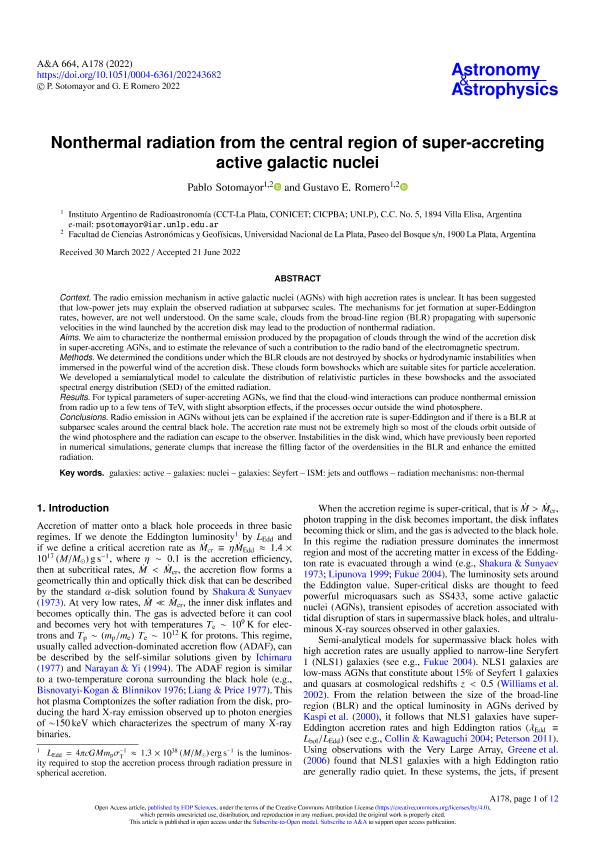Mostrar el registro sencillo del ítem
dc.contributor.author
Sotomayor Checa, Pablo Omar

dc.contributor.author
Romero, Gustavo Esteban

dc.date.available
2023-10-17T14:07:29Z
dc.date.issued
2022-08
dc.identifier.citation
Sotomayor Checa, Pablo Omar; Romero, Gustavo Esteban; Nonthermal radiation from the central region of super-accreting active galactic nuclei; EDP Sciences; Astronomy and Astrophysics; 664; 8-2022; 1-12
dc.identifier.issn
0004-6361
dc.identifier.uri
http://hdl.handle.net/11336/215183
dc.description.abstract
Context. The radio emission mechanism in active galactic nuclei (AGNs) with high accretion rates is unclear. It has been suggested that low-power jets may explain the observed radiation at subparsec scales. The mechanisms for jet formation at super-Eddington rates, however, are not well understood. On the same scale, clouds from the broad-line region (BLR) propagating with supersonic velocities in the wind launched by the accretion disk may lead to the production of nonthermal radiation. Aims. We aim to characterize the nonthermal emission produced by the propagation of clouds through the wind of the accretion disk in super-accreting AGNs, and to estimate the relevance of such a contribution to the radio band of the electromagnetic spectrum. Methods. We determined the conditions under which the BLR clouds are not destroyed by shocks or hydrodynamic instabilities when immersed in the powerful wind of the accretion disk. These clouds form bowshocks which are suitable sites for particle acceleration. We developed a semianalytical model to calculate the distribution of relativistic particles in these bowshocks and the associated spectral energy distribution (SED) of the emitted radiation. Results. For typical parameters of super-accreting AGNs, we find that the cloud-wind interactions can produce nonthermal emission from radio up to a few tens of TeV, with slight absorption effects, if the processes occur outside the wind photosphere. Conclusions. Radio emission in AGNs without jets can be explained if the accretion rate is super-Eddington and if there is a BLR at subparsec scales around the central black hole. The accretion rate must not be extremely high so most of the clouds orbit outside of the wind photosphere and the radiation can escape to the observer. Instabilities in the disk wind, which have previously been reported in numerical simulations, generate clumps that increase the filling factor of the overdensities in the BLR and enhance the emitted radiation.
dc.format
application/pdf
dc.language.iso
eng
dc.publisher
EDP Sciences

dc.rights
info:eu-repo/semantics/openAccess
dc.rights.uri
https://creativecommons.org/licenses/by-nc-sa/2.5/ar/
dc.subject
GALAXIES: ACTIVE
dc.subject
GALAXIES: NUCLEI
dc.subject
GALAXIES: SEYFERT
dc.subject
ISM: JETS AND OUTFLOWS
dc.subject
RADIATION MECHANISMS: NON-THERMAL
dc.subject.classification
Otras Ciencias Naturales y Exactas

dc.subject.classification
Otras Ciencias Naturales y Exactas

dc.subject.classification
CIENCIAS NATURALES Y EXACTAS

dc.title
Nonthermal radiation from the central region of super-accreting active galactic nuclei
dc.type
info:eu-repo/semantics/article
dc.type
info:ar-repo/semantics/artículo
dc.type
info:eu-repo/semantics/publishedVersion
dc.date.updated
2023-10-12T11:28:51Z
dc.journal.volume
664
dc.journal.pagination
1-12
dc.journal.pais
Francia

dc.description.fil
Fil: Sotomayor Checa, Pablo Omar. Provincia de Buenos Aires. Gobernación. Comisión de Investigaciones Científicas. Instituto Argentino de Radioastronomía. Consejo Nacional de Investigaciones Científicas y Técnicas. Centro Científico Tecnológico Conicet - La Plata. Instituto Argentino de Radioastronomía; Argentina
dc.description.fil
Fil: Romero, Gustavo Esteban. Provincia de Buenos Aires. Gobernación. Comisión de Investigaciones Científicas. Instituto Argentino de Radioastronomía. Consejo Nacional de Investigaciones Científicas y Técnicas. Centro Científico Tecnológico Conicet - La Plata. Instituto Argentino de Radioastronomía; Argentina
dc.journal.title
Astronomy and Astrophysics

dc.relation.alternativeid
info:eu-repo/semantics/altIdentifier/doi/http://dx.doi.org/10.1051/0004-6361/202243682
Archivos asociados
